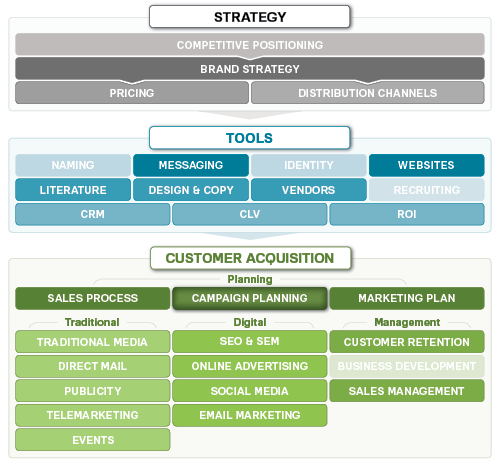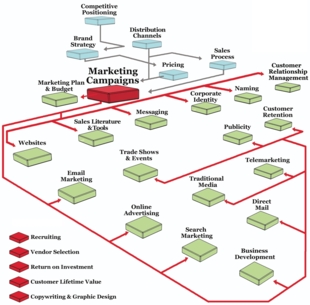Marketing Guides
Strategic Planning
Marketing Campaigns
For many companies, marketing campaigns are the main method for both communicating with their market to reinforce their positioning, and for customer acquisition.
Good campaigns follow a theme and include a series of touches with the market. It’s noisy in the marketplace, and a message delivered once through a single medium rarely makes a difference. While there’s no magic number regarding the best frequency for a message to make an impact, opinions range from three to twenty times, with seven being an old marketing adage.
Many marketing campaigns contain an overarching theme, which can be leveraged over extended periods of time with multiple variations, or different elements, to tell an entire story.
Note: You can access guided campaign planning templates in Qlutch, our marketing planning app.
Marketing Campaign Examples
An example would be The Duck campaign launched by the American Family Life Assurance Company in 2000. While the company had been in business since 1955, it had only a 12% brand recognition rate before the campaign launched. The company used the Kaplan Thaler Group to improve its name recognition. Kaplan created a new character, the Aflac Duck, who appeared in ads featuring customers who had trouble remembering the insurance company’s name. In the ads, the duck appeared in the background and quacked the name “Aflac” (while usually ending up in a funny predicament).

You’ve seen them, right? As a result of the long-running campaign, Aflac’s brand recognition jumped from 12% to 90%, and increased sales catapulted Aflac into a leadership position in the supplemental insurance market.
In 2013, the campaign keeps evolving. The duck recently got hurt; now you can use Facebook to send the duck a get well card.
Large consumer marketers like Alfac typically use ad agencies (both traditional media and digital media agencies) to design their campaign creative, handle the media buys, and track results. These are often multi-million dollar endeavors, and have brought us such memorable advertising campaigns as:
- “Just Do It” – Nike
- “The Most Interesting Man in the World” – Dos Equis
- “Where’s the Beef?” – Wendy’s
- “We Try Harder” – Avis
- “Absolutely, Positively Overnight” – FedEx
Marketing Mediums for Campaigns
While most small- to mid-market companies can’t afford the multi-million dollar ad budgets from the Madison Avenue agencies, they can create effective and memorable campaigns leveraging different media such as:
- Online media, including interactive ads and banners on websites
- Print media
- Social media
- Publicity
- Direct mail
- Radio
- Television
- Telemarketing
- Events and trade shows
- Search engines
- Outdoor media
True marketing campaigns are more than just advertisements. Complex campaigns leverage multiple mediums, use a sequence of messages over an extended timeframe, support positioning, define a brand experience, and handle the campaign fulfillment and selling.
Campaigns can also be simple – using a single medium, with a single message and call-to-action. Here are three examples of very simple campaigns:
| GENERATE NEW LEADS | DRIVE EXISTING PROSPECTS TO YOUR TRADE SHOW BOOTH & VIP RECEPTION | HIT YOUR MARKET WITH A SPECIAL OFFER |
|---|---|---|
| 1. Use search to generate traffic to your website.
2. Receive information request from prospect via landing page form. 3. Email the requested information. 4. Call the prospect; qualify the prospect further and determine next steps. |
1. Mail a postcard to attendees three weeks before the show; invite them to your booth with an intriguing incentive.
2. Mail a special invite to key prospects and customers for a VIP reception. Ask them to RSVP by phone, email or URL. 3. Call key prospects and customers as a second effort. 4. Send an email to all confirmed attendees 3 days before the event. 5. Email the non-respondents one last time. |
1. Run banner ads on industry websites and targeted email newsletters.
2. Send out a special email to your house list. 3. Create an intriguing story and tie it to your offer. Write a search-optimized press release and post it on your site; distribute release and pitch to a key industry reporter. 4. Run a series of paid search ads. |
If you’re planning a group of campaigns for your marketing plan, it’s good practice to start with your annual goals and work backward to develop campaigns to meet those numbers. For example, when you know how many new customers you need, you can calculate how many leads you’ll need, and then design campaigns to generate that number of leads over the course of the year.
With solid planning, a jolt of creativity, and a focus on measurement, you’ll be in a strong position for success.
| Best Case | Neutral Case | Worst Case |
|---|---|---|
| You plan and execute your campaigns to hit specific goals. You don’t always hit them, but you test and improve different elements; the ROI on your overall budget is above your goal.
You focus on an offer and call-to-action, and you touch your prospects several times and follow up when appropriate. You recognize the challenges in measuring results, but you do what you can; it helps you improve the next time around. |
Your campaigns aren’t the most creative or the splashiest, but you’ve hit many of your marketing goals. You don’t test, but your response rate is fine. You don’t know your ROI, but you know generally which campaigns work best.
When you’re faced with ambitious annual goals, you have problems gaining budget approval. Since you stick with the same campaigns, year in and year out, it’s also difficult to figure out how to generate additional leads. |
Your marketing programs tend to be reactive – suddenly you’re low on leads or falling short of your goals and you launch a campaign to fix the problem.
Since your programs don’t seem to work, it’s difficult to gain budget approval for future campaigns that could be better-planned and executed. It’s a vicious cycle and you don’t know how to get out of it. |
Not Sure Where to Start with Your Marketing Campaigns?
Access detailed step-by-step plans in our new marketing website.
It’s free to use
How Planning for Marketing Campaigns Aligns with Your Brand Strategy
Your marketing campaigns are the vehicles for connecting with your marketplace, to generate leads and sales, and to position you as that certain “something.”
Campaign copy and creative should always support your brand strategy and messages, even if you’re running a tactical lead generation campaign. They’re one of the most effective customer acquisition tactics in your marketing arsenal. If you want to see what your target market is thinking or doing, there are cutting edge tools using AI for market research and market intelligence that can help you better understand how to shape your campaign creative and messaging.
Key Concepts and Steps
Quantify your goals
- Plan your campaigns to meet your annual revenue and volume goals. For example, if you’re trying to generate 100 new customers, figure out how many leads you’ll need and when you’ll need them.
- Think about how you’ll use different media. For example, if you’re B2B, your sales team may be able to generate 30% of your leads through prospecting; the rest may come from telemarketing, email, social media, direct mail, search marketing, webinars, trade shows, etc.
Generate campaign ideas and strategies
- Identify all of the business goals that will need marketing support. You may need campaigns to generate and nurture prospects, to sell direct or through a channel, or to market to existing customers.
- Evaluate ideas and options (traditional sales activities, Internet marketing, social media, telemarketing, direct mail, email and publicity) to determine which ones are most effective for meeting a particular goal.
Target your audience
- With more specific targeting, you can speak more directly to the prospect and raise your response rates in the process.
Deliver one or two key messages and your call-to-action
- If you include every detail about your offering, it’s easy for prospects to become overwhelmed. Move a prospect just one step at a time.
- Be creative — your market is bombarded with messages daily, so grab their attention and engage them.
Create your budget and estimate your return on investment
Projecting marketing ROI is a powerful exercise that forces you to think through and estimate results for the important metrics of your campaign:
- Impressions, or exposure to your campaign creative
- Conversions, or those who take action from the impression
- The steps required to move from a conversion to a customer
- The number of units sold, and the profit from each
- The items of your campaign budget
- The estimated ROI of your campaign
Plan your fulfillment
- Your fulfillment processes can help or hurt your close rate, so be sure you outline your requirements. For example, if you’re running a campaign where prospects request a software demo, and it doesn’t arrive for a week, your prospects may lose interest.
Plan to measure
When you measure your campaigns, it’s easier to gain budget approval the next time around. You’ll also know exactly which programs produce the highest return.
- Establish how you’ll measure each campaign. If there are variables you can’t measure, decide how you will account for those results.
- Identify how you’ll capture the data you need – unique phone numbers, unique URLs, etc.
Continually test and improve
- Even on a small campaign, you can evaluate your ad, your copy, your list or other factors before you spend your entire budget.
- Choose a subset of your list or two versions of an ad; test them in small quantities and choose the best one for rollout. Then you can test a second variable against the winner of the first test.
- Keep the testing cycle going and track your results over time. You’ll improve your response rates and your return on investment.
Improving Your Marketing Campaigns
After you plan your campaign, it’s time to focus on tactical execution. That means having a deep understanding of the media you’re using, carefully planning your media buys, tracking your results, and following the best practices and steps for each media you use.
Check out our marketing campaign planning tools if you’d like guidance.
MARKETING CAMPAIGN PLANNING TEMPLATES / MARKETING PLANS / PROJECT MANAGEMENT
EVERYTHING YOU NEED FOR YOUR MARKETING PROJECT

